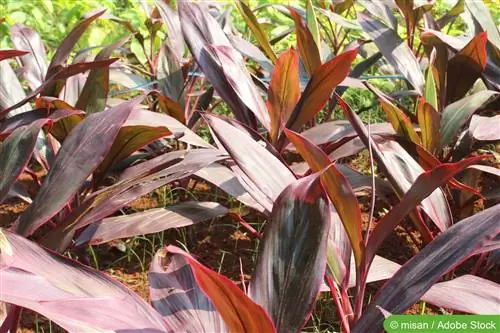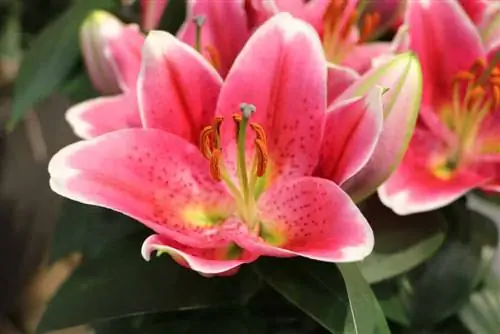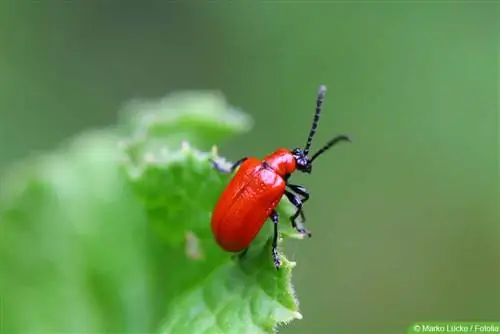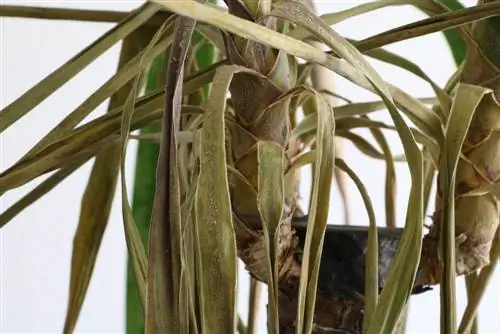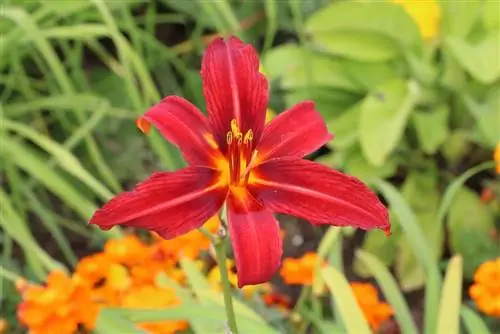- Author admin [email protected].
- Public 2023-12-17 03:39.
- Last modified 2025-01-24 12:45.
The club lily may not have the prettiest name, but the often multi-colored tint of its leaves is an attractive eye-catcher. Red, yellow or striped, it brings a fresh zest to the green plants and an exotic touch. Because the Cordyline, as the club lily is also called, originally comes from tropical rainforests and this is clearly visible. However, due to its origins, it also requires a certain level of coordinated care.
Varieties
The Cordyline is fundamentally differentiated into two groups, namely warm house and cold house club lilies. They differ in their location and care requirements, so a clear distinction is important. Warm house club lilies include Cordyline terminalis and Cordyline fruticosa. Cordyline indivisia and Cordyline australis are the best-known cold house club lilies.
Location
Both groups of club lilies require a sunny to partially shaded location. But they shouldn't have to endure the blazing midday sun. However, the more colorful the leaves, the brighter the location needs to be. If there is not enough light, they lose their decorative tint.
Aside from brightness, each Cordyline group prefers different conditions at the location. The warm house varieties prefer to be kept indoors. Here you want high humidity all year round and only small temperature fluctuations of around 20 °C. Cold house varieties are more robust here. They are allowed to stand outdoors from late spring to early autumn and are kept cool over the winter. They also get along well with normal humidity of 40% to 60% and therefore require less care.
Tip:
Warm house club lilies are best kept in the bathroom or kitchen, where the humidity is already higher.
Substrate
The club lily wants a loose substrate that is well permeable to water and contains little lime. A mixture of special potting soil and coconut fiber is well suited. Alternatively, it can also be used in hydroponics.
Tip:
To ensure that the water drains away safely, a drainage layer, for example made of broken clay or coarse gravel, should be placed at the bottom of the pot.
Pouring
Because the club lily comes from tropical rainforests, it has a high water and moisture requirement. The substrate must therefore always be kept moist, but must not be persistently wet. The higher the temperature, the more water is necessary. In addition to watering, the Cordyline, at least the representatives of the warm house group, requires high humidity. If the plant is in the kitchen or bathroom, spraying is rarely necessary. The situation is different in mostly dry rooms, such as the living room or study. In summer and when the air is warm, you should use the spray bottle every day or at least several times a week. Only low-lime water should be used for watering and spraying. Soft, filtered or stale tap water as well as rainwater are ideal.
Fertilize
The club lily needs regular doses of fertilizer. Here again there is a clear difference between the two groups. The heat-loving Cordyline is supplied with complete liquid fertilizer every month throughout the year. The K althaus Cordyline is much more frugal. She receives fertilizer from March to August, also every four weeks.
Blend
The club lily doesn't need any waste, but it doesn't take offense either. However, this only applies if the shortening is not excessive. The Cordyline can therefore be shortened if it takes up too much space. This involves cutting directly on the trunk. Following the cutting, the plant usually sprouts again in a branched manner, i.e. in several places. Through targeted interventions, unusual growth forms can be created.
Propagation
The most successful and at the same time easiest ways of propagation are germinating seeds and rooting stem cuttings.
The following procedure is recommended for propagating the club lily by seeds:
- The seeds are soaked in lukewarm water for a day.
- For cultivation, a mixture of equal parts potting soil and coconut fiber or sand is prepared.
- The pre-swollen seeds are lightly pressed into the substrate mixture and only thinly covered with soil.
- After watering, the planter is covered with transparent film or a glass pane to keep the humidity as evenly as possible.
- The pot is moved to a warm, bright place. Temperatures of around 25 °C are necessary for rapid and he althy germination.
Even under optimal conditions, germination takes at least a month. Propagating the club lily through a stem cutting promises somewhat quicker success. To do this, the upper 10 cm to 20 cm of the trunk including the crown of leaves are cut off. The interface should be allowed to dry for one to two hours before the cutting is placed in the soil mixture described above. Here it is watered and, like the seeds, kept warm and moist.
Tip:
In order to ensure the necessary temperature throughout, culture in a heated indoor greenhouse is the ideal solution.
Wintering
As with location and care, there is a clear difference between the two groups of club lilies when it comes to overwintering. Representatives of the warm house cordyline do not require any special care during the winter and remain in their usual location. Only the drying effect of the heating air should be compensated for by giving the plant a spray shower several times a week. Cold house types offer a little more freedom here. They can be overwintered at normal room temperatures or cool, around 10°C. In any case, you need a bright location and still need to be watered. However, the substrate may dry slightly between waterings.
Typical care errors, pests and diseases
The most typical care mistakes are a location that is too dark and the humidity is too low. If there is no light, colorful leaves turn green. Green leaves, on the other hand, turn yellow. On the one hand, too low humidity can lead to dried leaf tips and, on the other hand, it makes the club lily more susceptible to pests. These include:
- Scale insects
- Spider mites
- Mealybugs
Whatever pests they are, frequent spraying prevents them. At the same time, increasing the humidity can kill the annoying insects. To do this, the plant is showered and packed in a bag while it is still wet. To avoid mold, the bag is ventilated every two to three days at the latest. If necessary, shower again and the treatment is repeated until there are no more pests on the club lily. In terms of diseases, the most common ones are fungal infections caused by a substrate that is too moist.
Frequently asked questions
Is the club lily poisonous?
The club lily is not poisonous, but not entirely harmless either. Because their leaves are sharp-edged and pointy, they pose a risk of injury, especially to small children and pets.
Why does the club lily lose its pattern?
Just like the bright colors, the patterns of the leaves also fall by the wayside if it receives too little sunlight. A change of location can quickly help.
What you should know in brief
The club lily originally comes from New Zealand. There are around 20 different varieties, some with quite colorful leaves. Cordyline australis has green leaves. In their homeland, the plants grow to a height of several meters, but in the pot they remain rather small. Club lilies are not related to lilies or palm trees. Agaves are their closest relatives. The club lilies are just as frugal as these, robust and easy to care for.
Tip:
The plants are ideal for outdoor use, whether for a terrace, balcony or patio. However, they are not frost hardy.
Location
- The club lily thrives best in a sunny and bright location all year round.
- If you put them outside, you have to get used to the sun slowly, otherwise you will get burns.
- Cordyline australis is also happy with a partially shaded location, without direct sunlight.
- The club lilies with colored leaves in particular need a lot of light so that the colorful leaves can develop.
Planting substrate
- The planting substrate should be permeable. You can use normal potting soil or cactus soil. Good drainage is important.
- You can mix river sand, perlite or volcanic rock under the soil so that the plant substrate is nice and loose and permeable.
- Repotting takes place approximately every 3 to 4 years.
Care
- The Cordyline australis plant ball should be kept evenly moist. Under no circumstances should it be wet, this will lead to root rot.
- Drying out the ball between waterings is tolerated once or twice, but should not be the rule.
- In the growth phase you water more abundantly, in winter only moderately. The root ball should not dry out.
- It is best to use lime-free water.
- The club lily likes to be sprayed with demineralized water every now and then, once a week. She loves high humidity.
Fertilize
- To fertilize, use a commercially available liquid green plant fertilizer, but only in half the concentration.
- Fertilization is carried out every 4 weeks from April to September.
Wintering
- The club lily is best overwintered in light and at around 5 to 10 ºC. The cooler the plant is, the less you have to water it.
- You can also overwinter them in the warm living room. But this usually results in a pest infestation.
- A cooler winter is better.
Buy
- You can get the club lily for just 20 euros in a size of 60 to 80 cm.
- The Cordyline australis “Red Star” are also available in this price range.
- Specimens that already have a really tall trunk are of course significantly more expensive.

